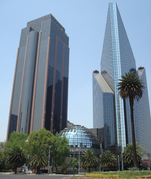Portal:Latin America
  Latin America often refers to the regions in the Americas in which Romance languages are the main languages and the culture and Empires of its peoples have had significant historical, ethnic, linguistic, and cultural impact. It is "commonly used to describe South America (with the exception of Suriname, Guyana and the Falkland islands), plus Central America, Mexico, and most of the islands of the Caribbean". In a narrow sense, it refers to Spanish America, and often it may also include Brazil (Portuguese America). The term "Latin America" may be used broader than Hispanic America, which specifically refers to Spanish-speaking countries; and narrower than categories such as Ibero-America, a term that refers to both Spanish and Portuguese-speaking countries from the Americas, and sometimes from Europe. It could also theoretically encompass Quebec or Louisiana where French is still spoken and are historical remnants of the French Empire in that region of the globe. The term Latin America was first used in Paris at a conference in 1856 called "Initiative of America: Idea for a Federal Congress of the Republics" (Iniciativa de la América. Idea de un Congreso Federal de las Repúblicas), by the Chilean politician Francisco Bilbao. The term was further popularized by French emperor Napoleon III's government of political strongman that in the 1860s as Amérique latine to justify France's military involvement in the Second Mexican Empire and to include French-speaking territories in the Americas, such as French Canada, Haiti, French Louisiana, French Guiana, Martinique, Guadeloupe and the French Antillean Creole Caribbean islands Saint Lucia, and Dominica, in the larger group of countries where Spanish and Portuguese languages prevailed. The region covers an area that stretches from Mexico to Tierra del Fuego and includes much of the Caribbean. It has an area of approximately 19,197,000 km2 (7,412,000 sq mi), almost 13% of the Earth's land surface area. In 2019, Latin America had a combined nominal GDP of US$5.1 trillion and a GDP PPP of US$10.2 trillion. (Full article...) Entries here consist of Good and Featured articles, which meet a core set of high editorial standards.
Domingo Faustino Sarmiento (Spanish: [doˈmiŋɡo saɾˈmjento]; born Domingo Faustino Fidel Valentín Sarmiento y Albarracín; 15 February 1811 – 11 September 1888) was an Argentine activist, intellectual, writer, statesman and President of Argentina. His writing spanned a wide range of genres and topics, from journalism to autobiography, to political philosophy and history. He was a member of a group of intellectuals, known as the Generation of 1837, who had a great influence on 19th-century Argentina. He was particularly concerned with educational issues and was also an important influence on the region's literature. Sarmiento grew up in a poor but politically active family that paved the way for many of his future accomplishments. Between 1843 and 1850, he was frequently in exile, and wrote in both Chile and in Argentina. His greatest literary achievement was Facundo, a critique of Juan Manuel de Rosas, that Sarmiento wrote while working for the newspaper El Progreso during his exile in Chile. The book brought him far more than just literary recognition; he expended his efforts and energy on the war against dictatorships, specifically that of Rosas, and contrasted enlightened Europe—a world where, in his eyes, democracy, social services, and intelligent thought were valued—with the barbarism of the gaucho and especially the caudillo, the ruthless strongmen of nineteenth-century Argentina. (Full article...)
Santiago (/ˌsæntiˈɑːɡoʊ/, US also /ˌsɑːn-/; Spanish: [sanˈtjaɣo]), also known as Santiago de Chile (Spanish: [san̪ˈtja.ɣo ðe ˈtʃi.le] ), is the capital and largest city of Chile and one of the largest cities in the Americas. It is located in the country's central valley and is the center of the Santiago Metropolitan Region, which has a population of seven million, representing 40% of Chile's total population. Most of the city is situated between 500–650 m (1,640–2,133 ft) above sea level. Founded in 1541 by the Spanish conquistador Pedro de Valdivia, Santiago has served as the capital city of Chile since colonial times. The city has a downtown core of 19th-century neoclassical architecture and winding side-streets featuring a mix of art deco, neo-gothic, and other styles. Santiago's cityscape is defined by several stand-alone hills and the fast-flowing Mapocho River, which is lined by parks such as Parque Forestal and Balmaceda Park. The Andes Mountains can be seen from most parts of the city and contribute to a smog problem, particularly during winter, due to the lack of rain. The outskirts of the city are surrounded by vineyards, and Santiago is within an hour's drive of both the mountains and the Pacific Ocean. (Full article...)
The following are images from various Latin America-related articles on Wikipedia.
Panorama of The Ruins of Sacsayhuamán, a main sight in the City of Cusco, the historic capital of the Inca Empire and Peru. It is a major tourist destination and receives almost 1.5 million visitors a year. Moai are monolithic human figures carved by the Rapa Nui people on Easter Island in eastern Polynesia between the years 1250 and 1500 CE.Nearly half are still at Rano Raraku, the main moai quarry, but hundreds were transported from there and set on stone platforms called ahu around the island's perimeter. Almost all moai have overly large heads three-eighths the size of the whole statue. The moai are chiefly the living faces (aringa ora) of deified ancestors (aringa ora ata tepuna).The statues still gazed inland across their clan lands when Europeans first visited the island, but most were cast down during later conflicts between clans.
Territories (in bold), dependencies, and subnational entities of a country not located primarily in Latin America are italicized.
North and Central America Caribbean South America |











































